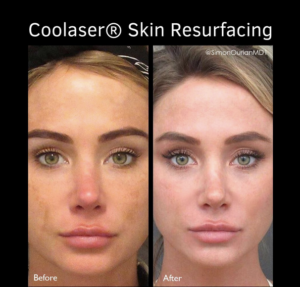Achieving a clear complexion and an even skin tone is a goal for many people. Coolaser®, a treatment that offers promising results, has been a popular option of choice. It is important to understand that the effectiveness of Coolaser® can vary depending on skin types and conditions. In this article, we will explore the relationship between Coolaser® and various skin types to uncover which ones it works best with and the factors that need careful consideration.
Which specific skin types are most suitable for Coolaser® treatment and why?
Here are the specific skin types that are generally considered suitable for Coolaser® along with the reasons why:
1. Fair to light skin tones: Coolaser® is particularly effective on individuals with fair to light skin tones because the laser targets pigmentation. There is a risk of experiencing effects like hyperpigmentation or hypopigmentation when treating darker skin tones.
2. Coolaser® is an option for individuals who have concerns about skin pigmentation issues like sunspots, age spots, melasma and post-inflammatory hyperpigmentation. It can be precise in reducing pigmentation to help improve the appearance of your skin.
3. If you are worried about lines and wrinkles, Coolaser® can be beneficial for you too. It stimulates collagen production, which leads to skin texture and a reduction in lines.
4. For those with skin tone or texture irregularities, Coolaser® can work wonders by creating a smoother and more complexion.
5. Whether you have scars or other types of scars, Coolaser® is effective in reducing their appearance and blending them seamlessly with your surrounding skin.
It is important to keep in mind that while Coolaser® is highly effective for these concerns, it may not be suitable for everyone. People with active infections, a history of keloid scarring, or certain medical conditions may not be candidates for this treatment due to potential risks. It is crucial to consult with a dermatologist or practitioner who can assess your suitability for Coolaser® and create a personalized treatment plan.
Which skin conditions benefit the most from this treatment?
Skin Conditions that benefit from Coolaser® treatment by Dr. Ourian are:
- Hyperpigmentation caused by sun damage
- Skin tone due to age spots or melasma
- Post-inflammatory hyperpigmentation resulting from scars or other injuries
By utilizing Coolaser®s technology, individuals with these specific skin concerns can experience noticeable improvements in their complexion.
It is important to note that while Coolaser® can be highly effective for these conditions, it may not completely eliminate them after a treatment. Optimal results may require sessions, so It is crucial to consult with a qualified dermatologist or practitioner who can assess the suitability of Coolaser® for specific skin concerns and develop an appropriate treatment plan.
What can individuals do to prepare their skin for Coolaser® treatment and maximize its compatibility and effectiveness?
To optimize the compatibility and effectiveness of Coolaser® laser skin resurfacing treatment, there are steps that individuals can take. These steps aim to ensure that the skin is in its condition for the procedure while minimizing the chances of any adverse effects. Here are some important measures to consider:
1. Consultation with an experienced practitioner:
It is essential to schedule a consultation with a dermatologist or practitioner who has expertise in administering Coolaser® treatment. This professional will carefully assess your skin type, concerns, and medical history in order to determine if Coolaser® is appropriate for you.
2. Minimize sun exposure:
It is advisable to limit sun exposure for 2 to 4 weeks prior to undergoing the procedure. This involves wearing sunscreen with a Sun Protection Factor (SPF) and protective clothing whenever you are outdoors.
3. Avoid tanning:
In the weeks leading up to your Coolaser® treatment, it is recommended that you refrain from using tanning beds or applying self-tanning products.
4. Make sure that there are no infections on the skin in the treatment area, such as acne, cold sores, or other skin conditions.
If you have any of these issues, it is important to resolve them before undergoing Coolaser® treatment.
5. Check Medications:
If you are taking medications that make your skin more sensitive to light (increase photosensitivity), your practitioner may advise you to stop taking them for a period before the treatment.
6. Adhere to fasting guidelines:
If anesthesia is involved in the procedure, make sure to follow any fasting guidelines given by your provider to ensure your safety during the treatment.
7. Arrange for post-treatment care:
Plan ahead for treatment care, including taking time off from work or social activities if needed, as there may be some recovery time associated with Coolaser®.
Your provider will give you instructions before your treatment based on your circumstances and the type of Coolaser® treatment you will be receiving. Following these guidelines can help maximize results and minimize complications.
In conclusion, when it comes to achieving flawless skin, we must understand the compatibility and limitations of Coolaser® that is crucial for obtaining outcomes. While Coolaser® can produce effects for individuals, it is equally important to recognize its constraints; by considering your skin type and concerns and seeking advice from a qualified professional, you can embark on a journey towards healthier and more vibrant skin while minimizing any potential risks. Your path toward skin harmony begins with knowledge and a qualified professional who will guide and prioritize your well-being.
